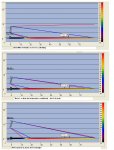I don't understand why a "line array" as commonly deployed would be expected to produce sound level that drops off like 1/R rather than 1/Rsquared. Sure the electromagnetic fields of a wire and a point source do drop off like 1/R and 1/Rsquared respectively, but to derive that result in physics you must make the assumption that the distant observation point receives field from every point on the linear wire, not just from one point on the wire. Mathematically, when you calculate the EM field at a point R meters from the wire you have to do the integral over the entire length of the wire so you are adding on some EM field from each point along the wire. A line array is set up to avoid interference of sound from multiple boxes (comb filtering) by having very narrow vertical coverage for each box. This means that a listener in the audience hears sound from primarily one box, not from all boxes in the line. So the fundamental assumption in deriving the 1/R drop off is violated. Avoiding interference among boxes and creating a sound field that drops off in SPL as 1/R seem mutually incompatible. Can anyone explain why we would expect the drop off of SPL from a line array to even approximate 1/R?
Being a pragmatic guy and accepting even not-very-good approximations, I am willing to ignore that the line array is not infinitely long, but I don't see how you can ignore the added complexity of vertical pattern control in each box. It just looks to me like the physics of a line array properly deployed to avoid comb filtering seems like a set of point sources only one of which is heard by any individual in the audience. So it should drop off like 1/Rsquared as Ivan has empirically observed.
Is it Marketing guys 1, fools like us 0? Or am I missing something important here?


